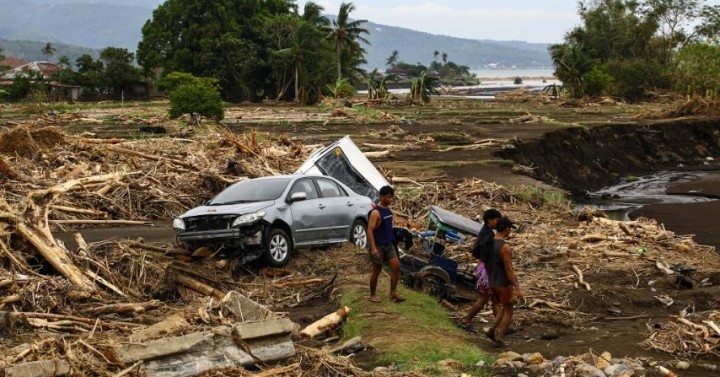UN Seeks $32.9 Million Aid for Philippines Weather Victims
MANILA – The recent onslaught of tropical storms in the Philippines has necessitated urgent humanitarian intervention, prompting the United Nations to seek USD 32.9 million to assist vulnerable communities across the nation. With the Philippine Humanitarian Country Team (HCT) leading this charge, the focus is on supporting approximately 210,000 people affected by these severe weather events, particularly in the regions of Bicol, Calabarzon, and Cagayan Valley.
Storms Devastate Communities
On October 24, 2024, Severe Tropical Storm Kristine (international name Trami) wreaked havoc over the Philippines, causing disastrous flooding and widespread structural damages. In Barangay Poblacion 3, Laurel, Batangas, the Bugaan Bridge was destroyed, isolating communities and disrupting transportation. Photos capturing the aftermath depict residents navigating through remnants of storm debris, including damaged vehicles like tricycles and the haunting remains of their livelihoods.
"The storm isn’t just a weather event; it’s a cry for help from the affected communities," stated UN Philippines Resident and Humanitarian Coordinator Gustavo Gonzalez. “We call on resource partners to rapidly support the Humanitarian Needs and Priorities (HNP) Plan to fill critical funding gaps generated by these exceptional series of storms,” he added in a statement dated November 12.
Humanitarian Needs and Priorities (HNP) Plan
The newly launched HNP aims not just to address immediate emergency needs but also to bolster long-term recovery efforts. Over the next three months, the plan will direct funds towards lifesaving efforts and protections focused on the most vulnerable populations, particularly women, girls, and individuals with disabilities.
Undersecretary Ariel Nepomuceno of the National Disaster Risk Reduction and Management Council (NDRRMC) expressed gratitude towards partner agencies for developing the HNP. He emphasized the importance of enhancing the government’s response capacity to better serve affected communities.
Collaborative Response from Humanitarian Agencies
The HCT, which comprises several agencies including the Food and Agriculture Organization (FAO) and the International Organization for Migration (IOM), is committed to rapidly collating resources and mobilizing relief efforts. This collaborative response is critical, especially given that the Philippines has been compelled to manage continuous cycles of recovery and disaster.
“Typhoons are overlapping. As soon as communities attempt to recover from the shock, the next tropical storm is already hitting them again. This relentless cycle exhausts response capacity and depletes financial resources,” Gonzalez expressed.
Ongoing Challenges and the Path Forward
Unfortunately, forecasters warn that another storm is expected to hit the region shortly, further complicating recovery efforts. The continued battering of tropical cyclones in the Philippines stresses local communities and strains governmental capabilities to respond effectively.
Importantly, the UN Central Emergency Relief Fund has approved USD 3.5 million in humanitarian assistance for organizations involved in the relief efforts, including the World Food Program, UN Children’s Fund, and UN Population Fund. These funds are aimed at addressing immediate needs and ensuring that aid reaches those most affected by the storms.
Impact on Vulnerable Populations
As areas grapple with the fallout from these hurricanes, the long-term effects on communities, particularly on vulnerable groups, cannot be overlooked. Many families find themselves without income, basic necessities, or safe shelter. The HNP plan not only aims to alleviate these immediate struggles but also focuses on empowering communities to rebuild stronger and more resiliently.
Despite the challenges posed by these natural disasters, the solidarity within the international community and the commitment of local agencies to mitigate the impact demonstrates a unified response.
Engage with the Development
As the world looks on, the effectiveness of this funding drive could significantly influence the Philippine response infrastructure and serve as a case study on humanitarian aid amid climate challenges. What do you think is the future for disaster-stricken regions? How can technology play a role in enhancing recovery efforts? Share your thoughts in the comments below.
For more insights into disaster management and technology’s role in humanitarian aid, consider reading our articles on related topics on Shorty-News. You may also find authoritative updates from sources like TechCrunch, The Verge, or Wired valuable.


![UK[Colefax & Fowler]2024 Fall/Winter new fabrics and trimmings 5 collection 37 designs 253 items will be released on November 13th UK[Colefax & Fowler]2024 Fall/Winter new fabrics and trimmings 5 collection 37 designs 253 items will be released on November 13th](https://news.biglobe.ne.jp/economy/1113/8424793675/98631_001_thum800.jpg)